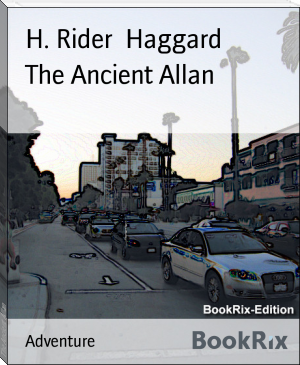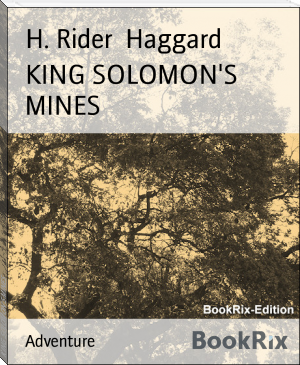Allan's Wife by H. Rider Haggard (read out loud books .txt) 📖

- Author: H. Rider Haggard
Book online «Allan's Wife by H. Rider Haggard (read out loud books .txt) 📖». Author H. Rider Haggard
“Well, we got to the place, and, hiding ourselves carefully in the trees at the foot of the kloof, watched the baboons playing about and grunting to each other, till at length, according to custom, they took the white one and three other little babies and put them in the cave. Then the old man came out, looked carefully round, called to his family, and went off with them over the brow of the kloof. Now very slowly and cautiously we crept up over the rocks till we came to the mouth of the cave and looked in. All the four little baboons were fast asleep, with their backs towards us, and their arms round each other’s necks, the white one being in the middle. Nothing could have been better for our plans. Hendrik, who by this time had quite entered into the spirit of the thing, crept along the cave like a snake, and suddenly dropped the mouth of the hide bag over the head of the white baboon. The poor little thing woke up and gave a violent jump which caused it to vanish right into the bag. Then Hendrik pulled the string tight, and together we knotted it so that it was impossible for our captive to escape. Meanwhile the other baby baboons had rushed from the cave screaming, and when we got outside they were nowhere to be seen.
“‘Come on, Missie,’ said Hendrik; ‘the babyans will soon be back.’ He had shouldered the sack, inside of which the white baboon was kicking violently, and screaming like a child. It was dreadful to hear its shrieks.
“We scrambled down the sides of the kloof and ran for home as fast as we could manage. When we were near the waterfall, and within about three hundred yards of the garden wall, we heard a voice behind us, and there, leaping from rock to rock, and running over the grass, was the whole family of baboons headed by the old man.
“‘Run, Missie, run!’ gasped Hendrik, and I did, like the wind, leaving him far behind. I dashed into the garden, where some Kaffirs were working, crying, ‘The babyans! the babyans!’ Luckily the men had their sticks and spears by them and ran out just in time to save Hendrik, who was almost overtaken. The baboons made a good fight for it, however, and it was not till the old man was killed with an assegai that they ran away.
“Well, there is a stone hut in the kraal at the stead where my father sometimes shuts up natives who have misbehaved. It is very strong, and has a barred window. To this hut Hendrik carried the sack, and, having untied the mouth, put it down on the floor, and ran from the place, shutting the door behind him. In another moment the poor little thing was out and dashing round the stone hut as though it were mad. It sprung at the bars of the window, clung there, and beat its head against them till the blood came. Then it fell to the floor, and sat upon it crying like a child, and rocking itself backwards and forwards. It was so sad to see it that I began to cry too.
“Just then my father came in and asked what all the fuss was about. I told him that we had caught a young white baboon, and he was angry, and said that it must be let go. But when he looked at it through the bars of the window he nearly fell down with astonishment.
“‘Why!’ he said, ‘this is not a baboon, it is a white child that the baboons have stolen and brought up!’
“Now, Mr. Allan, whether my father is right or wrong, you can judge for yourself. You see Hendrika—we named her that after Hendrik, who caught her—she is a woman, not a monkey, and yet she has many of the ways of monkeys, and looks like one too. You saw how she can climb, for instance, and you hear how she talks. Also she is very savage, and when she is angry or jealous she seems to go mad, though she is as clever as anybody. I think that she must have been stolen by the baboons when she was quite tiny and nurtured by them, and that is why she is so like them.
“But to go on. My father said that it was our duty to keep Hendrika at any cost. The worst of it was, that for three days she would eat nothing, and I thought that she would die, for all the while she sat and wailed. On the third day, however, I went to the bars of the window place, and held out a cup of milk and some fruit to her. She looked at it for a long while, then crept up moaning, took the milk from my hand, drank it greedily, and afterwards ate the fruit. From that time forward she took food readily enough, but only if I would feed her.
“But I must tell you of the dreadful end of Hendrik. From the day that we captured Hendrika the whole place began to swarm with baboons which were evidently employed in watching the kraals. One day Hendrik went out towards the hills alone to gather some medicine. He did not come back again, so the next day search was made. By a big rock which I can show you, they found his scattered and broken bones, the fragments of his assegai, and four dead baboons. They had set upon him and torn him to pieces.
“My father was very much frightened at this, but still he would not let Hendrika go, because he said that she was human, and that it was our duty to reclaim her. And so we did—to a certain extent, at least. After the murder of Hendrik, the baboons vanished from the neighbourhood, and have only returned quite recently, so at length we ventured to let Hendrika out. By this time she had grown very fond of me; still, on the first opportunity she ran away. But in the evening she returned again. She had been seeking the baboons, and could not find them. Shortly afterwards she began to speak—I taught her—and from that time she has loved me so that she will not leave me. I think it would kill her if I went away from her. She watches me all day, and at night sleeps on the floor of my hut. Once, too, she saved my life when I was swept down the river in flood; but she is jealous, and hates everybody else. Look, how she is glaring at you now because I am talking to you!”
I looked. Hendrika was tramping along with the child in her arms and staring at me in a most sinister fashion out of the corners of her eyes.
While I was reflecting on the Baboon-woman’s strange story, and thinking that she was an exceedingly awkward customer, the path took a sudden turn.
“Look!” said Stella, “there is our home. Is it not beautiful?”
It was beautiful indeed. Here on the western side of the great peak a bay had been formed in the mountain, which might have measured eight hundred or a thousand yards across by three-quarters of a mile in depth. At the back of this indentation the sheer cliff rose to the height of several hundred feet, and behind it and above it the great Babyan Peak towered up towards the heavens. The space of ground, embraced thus in the arms of the mountain, as it were, was laid out, as though by the cunning hand of man, in three terraces that rose one above the other. To the right and left of the topmost terrace were chasms in the cliff, and down each chasm fell a waterfall, from no great height, indeed, but of considerable volume. These two streams flowed away on either side of the enclosed space, one towards the north, and the other, the course of which we had been following, round the base of the mountain. At each terrace they made a cascade, so that the traveller approaching had a view of eight waterfalls at once. Along the edge of the stream to our left were placed Kaffir kraals, built in orderly groups with verandahs, after the Basutu fashion, and a very large part of the entire space of land was under cultivation. All of this I noted at once, as well as the extraordinary richness and depth of the soil, which for many ages past had been washed down from the mountain heights. Then following the line of an excellent waggon road, on which we now found ourselves, that wound up from terrace to terrace, my eye lit upon the crowning wonder of the scene. For in the centre of the topmost platform or terrace, which may have enclosed eight or ten acres of ground, and almost surrounded by groves of orange trees, gleamed buildings of which I had never seen the like. There were three groups of them, one in the middle, and one on either side, and a little to the rear, but, as I afterwards discovered, the plan of all was the same. In the centre was an edifice constructed like an ordinary Zulu hut—that is to say, in the shape of a beehive, only it was five times the size of any hut I ever saw, and built of blocks of hewn white marble, fitted together with extraordinary knowledge of the principles and properties of arch building, and with so much accuracy and finish that it was often difficult to find the joints of the massive blocks. From this centre hut ran three covered passages, leading to other buildings of an exactly similar character, only smaller, and each whole block was enclosed by a marble wall about four feet in height.
Of course we were as yet too far off to see all these details, but the general outline I saw at once, and it astonished me considerably. Even old Indaba-zimbi, whom the Baboon-woman had been unable to move, deigned to show wonder.
“Ou!” he said; “this is a place of marvels. Who ever saw kraals built of white stone?”
Stella watched our faces with an expression of intense amusement, but said nothing.
“Did your father build those kraals?” I gasped, at length.
“My father! no, of course not,” she answered. “How would it have been possible for one white man to do so, or to have made this road? He found them as you see.”
“Who built them, then?” I said again.
“I do not know. My father thinks that they are very ancient, for the people who live here now do not know how to lay one stone upon another, and these huts are so wonderfully constructed that, though they must have stood for ages, not a stone of them had fallen. But I can show you the quarry where the marble was cut; it is close by and behind it is the entrance to an ancient mine, which my father thinks was a silver mine. Perhaps the people who worked the mine built
 Nowadays a big variety of genres are exist. In our electronic library you can choose any book that suits your mood, request and purpose. This website is full of free ebooks. Reading online is very popular and become mainstream. This website can provoke you to be smarter than anyone. You can read between work breaks, in public transport, in cafes over a cup of coffee and cheesecake.
Nowadays a big variety of genres are exist. In our electronic library you can choose any book that suits your mood, request and purpose. This website is full of free ebooks. Reading online is very popular and become mainstream. This website can provoke you to be smarter than anyone. You can read between work breaks, in public transport, in cafes over a cup of coffee and cheesecake.




Comments (0)